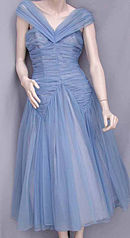
Tulle (/tuːl/ TOOL) is a form of netting that is made of small-gauge thread, netted in a hexagonal pattern with small openings, and frequently starched to provide body or stiffness. It is a finer textile than the textile referred to as "net."
It is a lightweight, very fine, stiff netting. It can be made of various fibres, including silk, nylon, polyester and rayon. Polyester is the most common fibre used for tulle. Rayon tulle is very rare. Tulle is most commonly used for veils, gowns (particularly wedding gowns), and ballet tutus. Tulle comes in a wide array of colors and it is readily available. It can be dyed at home if it is made from nylon, rayon or silk but not if it's made from polyester.

The name comes from Tulle, a city in the southern central region of France. Tulle was well known as a center of lace and silk production in the 18th century, and early tulle netting probably originated in this French city. Tulle netting certainly appeared earlier in Parisian ballet costume than in most other nations, suggesting that tulle netting may have been more readily available there than elsewhere.
One of the most common uses for tulle netting is in garments. Tulle is often used as an accent, to create a lacy, floating look. Tulle may also be used in underskirts or petticoats to create a stiff belled shape. Gowns are often puffed out with the use of several layers of stiff tulle. Tulle netting is also used to make veils, since it obscures the features of the face while allowing the wearer to see out.
Decorative ornaments can also be made from tulle netting. It is frequently used to wrap up party favors and gifts, especially for weddings and baby showers. Scraps of tulle netting are sometimes used in quilting and crafts as well, to add texture to a project. Multicolored tulle netting is often used for this purpose, to create tulle flowers and other ornamental accents.
See also
- Organza, a woven sheer fabric
- Gossamer (fabric)
- Gauze
References
- "Net (textile)", Misplaced Pages, 2021-10-11, retrieved 2022-10-21
- Manscill, D.C. (Nov 6, 2019). "Girl's Tulle Dresses". Children's Formal Attire. p. 1. Retrieved 6 November 2019.
Further reading
- Ferguson, S. (1862). L'Histoire du tulle et des dentelles mécaniques en Angleterre et en France [The history of tulle and mechanical lace in England and France] (in French). Paris: E. Lacroix.
This article about textiles is a stub. You can help Misplaced Pages by expanding it. |